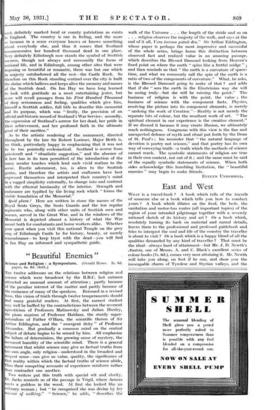The Scottish National War Memorial
Their Name Liveth : the Book of the Scottish National War
MOST truly national is the Scottish War Memorial. In no way is the sense, of Scottish unity in this high matter more clearly proved than by a fact recorded in Ian Hay's monograph : " The first subscription actually received was one of five hundred pounds from a prominent man of business. The second was half-a-crown, sent by an ex-tinker serving with the Black Watch in France." ..
Apart from the historic division between Highland and Lowland—and that did not always obtain—Scotland has no such definitely marked local or county patriotism as exists in England. The country is one in feeling, and the more so because in a sense everyone knows or knows something about everybody else, and thus it comes that Scotland commemorates her hundred thousand dead in one place. Very definitely Edinburgh now stands the symbol of Scottish oneness, though not always and necessarily the focus of ational life, and in Edinburgh, among other sites that were mposing or beautiful or romantic, there was but one which in majesty outshadowed all the rest—the Castle Rock. So therefore on this Rock standing sentinel over the city is built he shrine which hallows and keeps alive the memory and names of the Scottish dead. On Ian Hay we have long learned to look with gratitude as a most entertaining jester, but scale will recall passages from his First Hundred Thousand f deep seriousness and feeling, qualities which give him, himself a Scottish soldier, full title to describe this memorial and its purpose, which was " firstly, the provision of an official and historic record of Scotland's War Service; secondly, he expression of Scotland's sorrow for her dead, her pride in their achievement, and her profound faith in the ultimate good of their sacrifice."
As to the artistic rendering of the monument, directed throughout by the late Sir Robert Lorimer, Major Beith is, we think, particularly happy in emphasizing that it was not to be too pointedly ecclesiastical. Scotland is averse from priestcraft and " ritualistic suggestion," and the absence of it here has in its turn permitted of the introduction of the many secular touches which lend such vivid realism to the scene. Exotic adornment, too, is alien to the Scottish enius, and therefore the artists and craftsmen have best expressed themselves and interpreted their country's mind in a rugged simplicity externally, to change into and contrast with the ethereal luminosity of the interior. Strength and endurance are typified by the living rock which " forms the visible foundation of the Memorial."
Quid plura ? Here are written in stone the names of the oyal Sebts Greys, the Scots Guards and the ten regular regiments who, along with other units of Scottish men and women, served in the Great War, and in the windows of the Memorial is depicted almost a history of what the War meant both for combatants and home workers alike. Whether your quest when you visit this national Temple on the grey crag of Edinburgh Castle be for history, beauty, or merely membrance—to keep 'tryst with the dead—you will find in Ian Hay an informed and sympathetic guide.







































 Previous page
Previous page